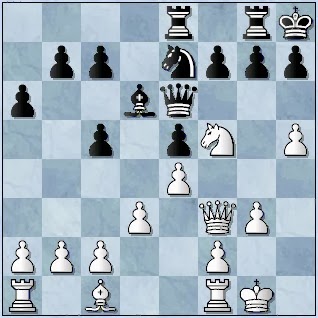Flipping to my notes and brooding over, i remember what happened during Rapid Merdeka Team 2007 at CitiTel Mid Valley where this position occurred on the board:
Black to move
I played black. White just moves his Queen to h8, threaten mate in one, Ra8++. I took a long time to think and my mind went something like this: Yes, white has threaten mate, but now, it is my turn to make a move. It is tempting to sacrifice exchange, 1. … Rxd3+ 2. cxd3 Qc1+ but then after King move to d4, what i’m supposed to do? Qa1 and skewer? Ah, that’s of course will fail since rook protects the queen.
I felt pity for myself. Throughout the game, i always felt like “attack! attack! swashbuckling attack!” and now, this?! Time is ticking and in state of immense pressure, i move 1 … b5 which was a big mistake and allows white to execute a mating combination. I was in big shock! (Pls find yourself the little combination ;P)
There were a few spectators who observed the game and when i still felt bad for losing after having a great game throughout, they came and showed to me how i simply missed a mate in the above position. The ironic is that they told me what i had been thinking during the game. 1. … Rxd3+ 2. cxd3 3. Qc1+ Kd4 4. Qa1 and what i was not aware was that, i didn’t have to think about skewer at all. It IS a mate!! I was like — , hmmmm, i guess you know how it was like! I guess, the final position of the unrealized-it-was-a-mate position deserves a diagram.
Back to JB, i told my friend how i missed the mate and he said, before i showed him the position, that that must be a case of mate where king is in the middle. He is right!! Such mate is hard to see, he added. Phew!
And you may ask: “heyy, what is this has to do with the topic we want to talk about?!”
Now i insist you, go and drink some coffee and go back to the initial position above. Visualize what i told you about forcing thingy. Our mind believes what we want to believe! Now look at this, again:

Do you remember that while in check, there are 3 ways of facing it: 1st-By capture the piece giving the check (no, not this one on double check!). 2nd-Block the check with our own piece (yeah, knight check is an exception to this of course). And what is the 3rd 0ne? Yes, simply moves the King from check!
If you find this, you should congratulate yourself: after 1 … Rxe3+, white is not forced to capture the rook! While in check, he has a tempo while the mate threat is still intact! So, 2. Kb2! Then the best thing black can do is to exchange the queen, 2. … Qd4+. After queen exchange and white King takes the black bishop, the position is about equal. [3. Kxa2 Qxh8 4. Rxh8= ]
After all, i learnt my precious lesson!














































